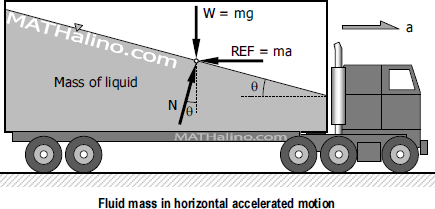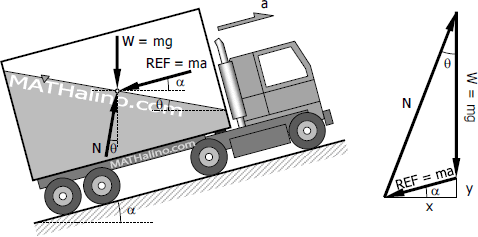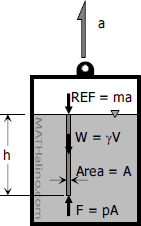Rectilinear Translation - Moving Vessel
Horizontal Motion
If a mass of fluid moves horizontally along a straight line at constant acceleration a, the liquid surface assume an angle θ with the horizontal, see figure below.

 For any value of a, the angle θ can be found by considering a fluid particle of mass m on the surface. The forces acting on the particle are the weight W = mg, inertia force or reverse effective force REF = ma, and the normal force N which is the perpendicular reaction at the surface. These three forces are in equilibrium with their force polygon shown to the right.
For any value of a, the angle θ can be found by considering a fluid particle of mass m on the surface. The forces acting on the particle are the weight W = mg, inertia force or reverse effective force REF = ma, and the normal force N which is the perpendicular reaction at the surface. These three forces are in equilibrium with their force polygon shown to the right.
From the force triangle
$\tan \theta = \dfrac{REF}{W}$
$\tan \theta = \dfrac{ma}{mg}$
Inclined Motion
Consider a mass of fluid being accelerated up an incline α from horizontal. The horizontal and vertical components of inertia force REF would be respectively, x = mah and y = mav.

From the force triangle above
$\tan \theta = \dfrac{x}{W + y}$
$\tan \theta = \dfrac{ma \cos \alpha}{mg + ma \sin \alpha}$
$\tan \theta = \dfrac{a \cos \alpha}{g + a \sin \alpha}$
but a cos α = ah and a sin α = av, hence
$\tan \theta = \dfrac{a_h}{g + a_v}$
Use (+) sign for upward motion and (-) sign for downward motion.
Vertical Motion
The figure shown to the right is a mass of liquid moving vertically upward with a constant acceleration a. The forces acting to a liquid column of depth h from the surface are weight of the liquid W = γV, the inertia force REF = ma, and the pressure F = pA at the bottom of the column.
 $\Sigma F_V = 0$
$\Sigma F_V = 0$
$F = W + REF$
$pA = \gamma V + ma$
$pA = \gamma V + \rho Va$
$pA = \gamma V + \dfrac{\gamma}{g} Va$
$pA = \gamma (Ah) + \dfrac{\gamma}{g} (Ah)a$
$p = \gamma h + \dfrac{\gamma}{g} ha$
$p = \gamma h \left(1 + \dfrac{a}{g}\right)$
Use (+) sign for upward motion and (-) sign for downward motion. Also note that a is positive for acceleration and negative for deceleration.
- Log in to post comments
